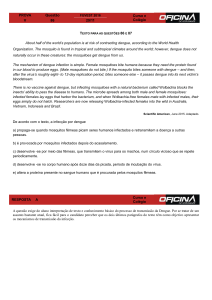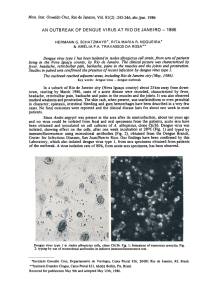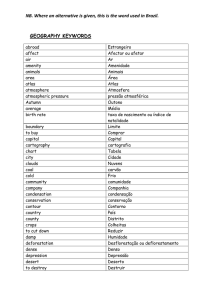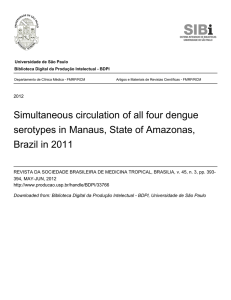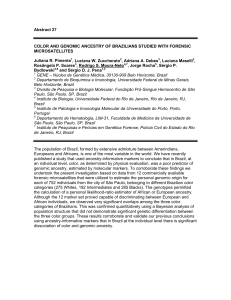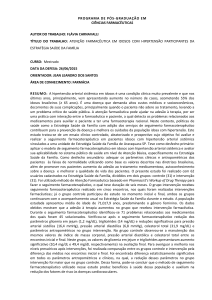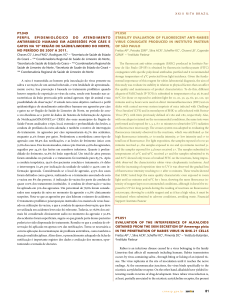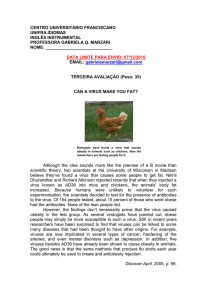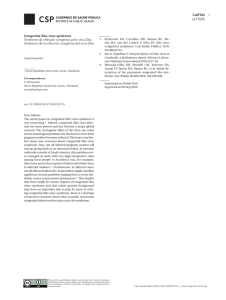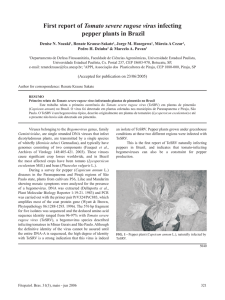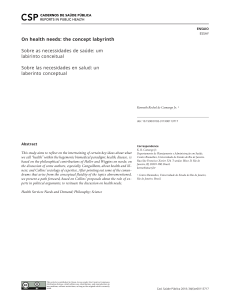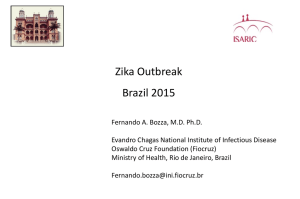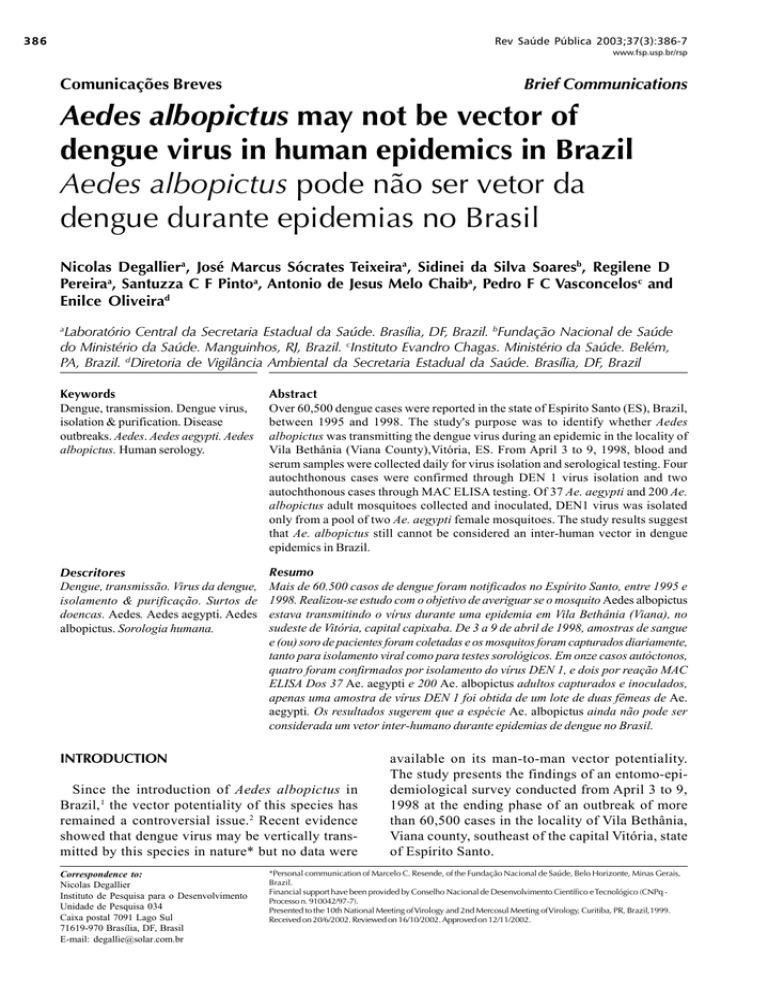
386
Rev Saúde Pública 2003;37(3):386-7
www.fsp.usp.br/rsp
Comunicações Breves
Brief Communications
Aedes albopictus may not be vector of
dengue virus in human epidemics in Brazil
Aedes albopictus pode não ser vetor da
dengue durante epidemias no Brasil
Nicolas Degalliera, José Marcus Sócrates Teixeiraa, Sidinei da Silva Soaresb, Regilene D
Pereiraa, Santuzza C F Pintoa, Antonio de Jesus Melo Chaiba, Pedro F C Vasconcelosc and
Enilce Oliveirad
a
Laboratório Central da Secretaria Estadual da Saúde. Brasília, DF, Brazil. bFundação Nacional de Saúde
do Ministério da Saúde. Manguinhos, RJ, Brazil. cInstituto Evandro Chagas. Ministério da Saúde. Belém,
PA, Brazil. dDiretoria de Vigilância Ambiental da Secretaria Estadual da Saúde. Brasília, DF, Brazil
Keywords
Dengue, transmission. Dengue virus,
isolation & purification. Disease
outbreaks. Aedes. Aedes aegypti. Aedes
albopictus. Human serology.
Abstract
Over 60,500 dengue cases were reported in the state of Espírito Santo (ES), Brazil,
between 1995 and 1998. The study's purpose was to identify whether Aedes
albopictus was transmitting the dengue virus during an epidemic in the locality of
Vila Bethânia (Viana County),Vitória, ES. From April 3 to 9, 1998, blood and
serum samples were collected daily for virus isolation and serological testing. Four
autochthonous cases were confirmed through DEN 1 virus isolation and two
autochthonous cases through MAC ELISA testing. Of 37 Ae. aegypti and 200 Ae.
albopictus adult mosquitoes collected and inoculated, DEN1 virus was isolated
only from a pool of two Ae. aegypti female mosquitoes. The study results suggest
that Ae. albopictus still cannot be considered an inter-human vector in dengue
epidemics in Brazil.
Descritores
Dengue, transmissão. Virus da dengue,
isolamento & purificação. Surtos de
doencas. Aedes. Aedes aegypti. Aedes
albopictus. Sorologia humana.
Resumo
Mais de 60.500 casos de dengue foram notificados no Espírito Santo, entre 1995 e
1998. Realizou-se estudo com o objetivo de averiguar se o mosquito Aedes albopictus
estava transmitindo o vírus durante uma epidemia em Vila Bethânia (Viana), no
sudeste de Vitória, capital capixaba. De 3 a 9 de abril de 1998, amostras de sangue
e (ou) soro de pacientes foram coletadas e os mosquitos foram capturados diariamente,
tanto para isolamento viral como para testes sorológicos. Em onze casos autóctonos,
quatro foram confirmados por isolamento do vírus DEN 1, e dois por reação MAC
ELISA Dos 37 Ae. aegypti e 200 Ae. albopictus adultos capturados e inoculados,
apenas uma amostra de vírus DEN 1 foi obtida de um lote de duas fêmeas de Ae.
aegypti. Os resultados sugerem que a espécie Ae. albopictus ainda não pode ser
considerada um vetor inter-humano durante epidemias de dengue no Brasil.
INTRODUCTION
Since the introduction of Aedes albopictus in
Brazil, 1 the vector potentiality of this species has
remained a controversial issue.2 Recent evidence
showed that dengue virus may be vertically transmitted by this species in nature* but no data were
Correspondence to:
Nicolas Degallier
Instituto de Pesquisa para o Desenvolvimento
Unidade de Pesquisa 034
Caixa postal 7091 Lago Sul
71619-970 Brasília, DF, Brasil
E-mail: [email protected]
available on its man-to-man vector potentiality.
The study presents the findings of an entomo-epidemiological survey conducted from April 3 to 9,
1998 at the ending phase of an outbreak of more
than 60,500 cases in the locality of Vila Bethânia,
Viana county, southeast of the capital Vitória, state
of Espírito Santo.
*Personal communication of Marcelo C. Resende, of the Fundação Nacional de Saúde, Belo Horizonte, Minas Gerais,
Brazil.
Financial support have been provided by Conselho Nacional de Desenvolvimento Científico e Tecnológico (CNPq Processo n. 910042/97-7).
Presented to the 10th National Meeting of Virology and 2nd Mercosul Meeting of Virology, Curitiba, PR, Brazil,1999.
Received on 20/6/2002. Reviewed on 16/10/2002. Approved on 12/11/2002.
Vectors of dengue in Brazil
Degallier N et al
Rev Saúde Pública 2003;37(3):386-7
www.fsp.usp.br/rsp
METHODS
Blood and/or serum samples of sick people were
drawn and mosquitoes, either resting or landing on
people, were collected daily inside and outside patients’ houses. Human sera were tested using MAC
ELISA (Enzyme-Linked ImmunoSorbent Assay) and
blood samples were inoculated into C6/36 Ae.
albopictus cell cultures for isolation attempts. The
mosquitoes were anaesthetized at 4°C, pooled (up to
20 spec. by pool) by date, site, species and sex, and
stored at -70°C until inoculation. The abdomens of
female mosquitoes were cut off in order to eliminate
any possible contamination of the pools with previously ingested blood. The pools were inoculated into
C6/36 cell cultures and intracerebrally into suckling
mice. In the absence of any cytopathic effect up to
the day 7, a blind passage was created which was
later tested on day 14 by indirect immunofluorescence test against polyclonal antibodies to dengue
1-4.4 Positives were then tested against monoclonal
antibodies to dengue 1-4. Mice were observed for
pathological signs during 21 days.
RESULTS
Eleven acute febrile human cases occurred during the survey period, of which 4 were confirmed
by isolation of DEN 1 virus, and 2 by MAC ELISA.
As per epidemiological evidences, they were all
probably autochthonous. Specimens of Ae. aegypti
(37) and Ae. albopictus (200) were inoculated (23
and 38 pools, respectively). One isolate of DEN 1
virus was obtained from 1 pool of 2 female Ae.
aegypti. No isolation was obtained from females
of Ae. albopictus or males of either species or from
any other species of mosquitoes (1073 ind.; 158
pools), despite the active circulation of DEN 1 virus and close association between viremic people
and mosquitoes.
DISCUSSION
As suggested by recent studies in the state of Minas Gerais and former experimental transmission studies, Ae. albopictus may be considered as a probable
vector of dengue 1, capable of getting infected and
transmitting dengue viruses to its progeny. The
present findings have not showed an association of
these mosquitoes with man-to-man transmission of
dengue in Brazil, despite the concomitant transmission of dengue 1 by Ae. aegypti. In the state of Espírito
Santo, no dengue virus has been isolated from male
or female mosquitoes bred from immature stages, suggesting that vertical transmission probably did not
occur at the ending phase of this epidemic. Such negative results do not exclude the possibility of this
mosquito to become an efficient vector of dengue or
other arboviruses in the future.3
ACKNOWLEDGEMENTS
To Nilson dos Santos Will, Everaldo Binda, Agenor
Barbosa de Oliveira, Jones Evandro de Oliveira,
Homero de Oliveira Almeida, Geraldo de Moura Leite
Filho da Secretaria Estadual de Saúde and Fundação
Nacional de Saúde, Vitória, ES, for their collaboration during the field part of the work.
REFERENCES
1. Forattini OP. Identificação de Aedes (Stegomyia)
albopictus (Skuse) no Brasil. Rev Saúde Pública
1986;20:244-5.
2. Marques CC de A, Marques GRA, Dégallier N. Is
Aedes albopictus only a pest mosquito or also a
vector of arboviruses in Brazil? In: Travassos da Rosa
APA, Vasconcelos PFC, Travassos da Rosa, JFS,
editors. An overview of arbovirology in Brazil and
neighbouring countries. Belém: Instituto Evandro
Chagas; 1998. p. 248-60.
3. Mitchell CJ. Vector competence of North and South
American strains of Aedes albopictus for certain
arboviruses: a review. J Amer Mosq Control Ass
1991;7:446-51.
4. Travassos da Rosa APA, Travassos da Rosa ES,
Travassos da Rosa JFS, Dégallier N, Vasconcelos PF
da C, Rodrigues SG. Os arbovírus no Brasil: generalidades, métodos e técnicas de estudo. Belém: Instituto
Evandro Chagas; 1994. (Documento técnico n. 2).
387

